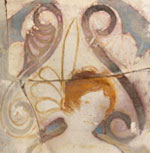Chemical Analysis Shows an Ancient Ceramic Vessel was Broken and Burned in
Cremation Burial
summary written by Raven Hanna
Anthropologists learn about ancient cultures through the objects left behind. Ritualistic artifacts give glimpses into the religious and belief systems of nonextant societies. Application of new techniques of chemical and structural analysis to the study of ancient objects can give more insight into how they were made and used.
A team led by Karen Trentelman of the Getty Conservation Institute in Los Angeles used SSRL Beam Line 2-3 to analyze the chemical composition of layers of glaze and aging on a funeral lekythoi, a Greek vessel for storing oil, from 5th century BCE Attica. They were particularly interested in a purplish discoloration on the surface layer of the lekythoi, and on many others like it. Using a variety of techniques, including electron probe microanalysis (EPMA), scanning electron microscopy (SEM), Micro x-ray absorption near edge structure (XANES), and extended x-ray absorption fine structure (EXAFS), the researchers found chemical evidence that the lekythoi was broken then burned with the body of the deceased as part of the funeral ceremony.
The analysis of this vessel deepens our understanding of Athenian customs.
Using this technique, other museum artifacts might also share more of their
ancient secrets. This work was published in the May 2010 issue of the Journal
of Archeological Science.
To learn more about this research see the full Scientific Highlight
M. S. Walton, M. Svoboda, A. Mehta, S. Webb and K. Trentelman, "Material Evidence for the Use of Attic White-ground Lekythoi Ceramics in Cremation Burials", J. Archaeol. Sci. 37, 936 (2010) doi: 10.1016/j.jas.2009.11.026


